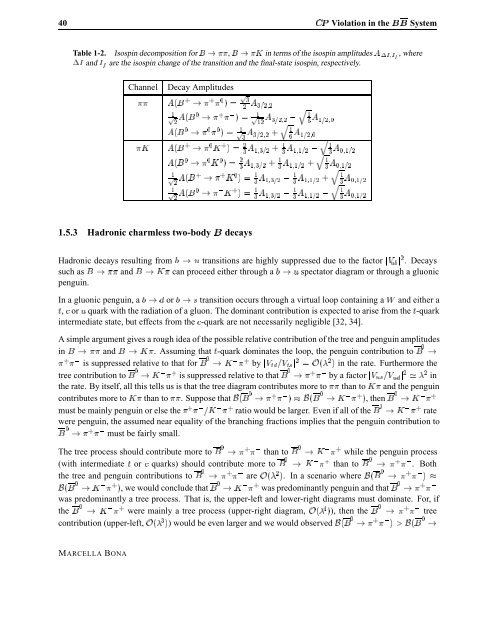Violation in Mixing
Violation in Mixing
Violation in Mixing
You also want an ePaper? Increase the reach of your titles
YUMPU automatically turns print PDFs into web optimized ePapers that Google loves.
40 �È <strong>Violation</strong> <strong>in</strong> the �� System<br />
Table 1-2. Isosp<strong>in</strong> decomposition for � � ��,� � �à <strong>in</strong> terms of the isosp<strong>in</strong> amplitudes � ¡Á�Á�, where<br />
¡Á and Á� are the isosp<strong>in</strong> change of the transition and the f<strong>in</strong>al-state isosp<strong>in</strong>, respectively.<br />
Channel Decay Amplitudes<br />
Ô<br />
�� � � � � � �<br />
� � �<br />
Ô �� �� � � Ô � � �<br />
Õ<br />
Õ<br />
� � � �<br />
� � � � � � Ô � � � ��� � Õ<br />
�à � � � � à � � � � � � � � � � Õ<br />
�� �� à � � � � � � � � � � Õ<br />
Ô �� �� à � � � � � � � � � � Õ<br />
Ô �� �� à � � � � � � � � � �<br />
1.5.3 Hadronic charmless two-body � decays<br />
Hadronic decays result<strong>in</strong>g from � � Ù transitions are highly suppressed due to the factor �ÎÙ�� . Decays<br />
such as � � �� and � � � can proceed either through a � � ٠spectator diagram or through a gluonic<br />
pengu<strong>in</strong>.<br />
In a gluonic pengu<strong>in</strong>, a � � � or � � × transition occurs through a virtual loop conta<strong>in</strong><strong>in</strong>g a Ï and either a<br />
Ø, or Ù quark with the radiation of a gluon. The dom<strong>in</strong>ant contribution is expected to arise from the Ø-quark<br />
<strong>in</strong>termediate state, but effects from the -quark are not necessarily negligible [32, 34].<br />
A simple argument gives a rough idea of the possible relative contribution of the tree and pengu<strong>in</strong> amplitudes<br />
<strong>in</strong> � � �� and � � Ã�. Assum<strong>in</strong>g that Ø-quark dom<strong>in</strong>ates the loop, the pengu<strong>in</strong> contribution to � �<br />
� � is suppressed relative to that for � � à � by �ÎØ��ÎØ×� � Ç � <strong>in</strong> the rate. Furthermore the<br />
tree contribution to � � à � is suppressed relative to that � � � � by a factor �ÎÙ×�ÎÙ�� � <strong>in</strong><br />
the rate. By itself, all this tells us is that the tree diagram contributes more to �� than to � and the pengu<strong>in</strong><br />
contributes more to � than to ��. Suppose that � � � � � �� � �à � , then � � à �<br />
must be ma<strong>in</strong>ly pengu<strong>in</strong> or else the � � �à � ratio would be larger. Even if all of the � � à � rate<br />
were pengu<strong>in</strong>, the assumed near equality of the branch<strong>in</strong>g fractions implies that the pengu<strong>in</strong> contribution to<br />
� � � � must be fairly small.<br />
The tree process should contribute more to � � � � than to � � Ã � while the pengu<strong>in</strong> process<br />
(with <strong>in</strong>termediate Ø or quarks) should contribute more to � � Ã � than to � � � � . Both<br />
the tree and pengu<strong>in</strong> contributions to � � � � are Ç � . In a scenario where � � � � � �<br />
� � � Ã � , we would conclude that � � Ã � was predom<strong>in</strong>antly pengu<strong>in</strong> and that � � � �<br />
was predom<strong>in</strong>antly a tree process. That is, the upper-left and lower-right diagrams must dom<strong>in</strong>ate. For, if<br />
the � � Ã � were ma<strong>in</strong>ly a tree process (upper-right diagram, Ç � � ), then the � � � � tree<br />
contribution (upper-left, Ç � ) would be even larger and we would observed � � � � � � � � �<br />
MARCELLA BONA















